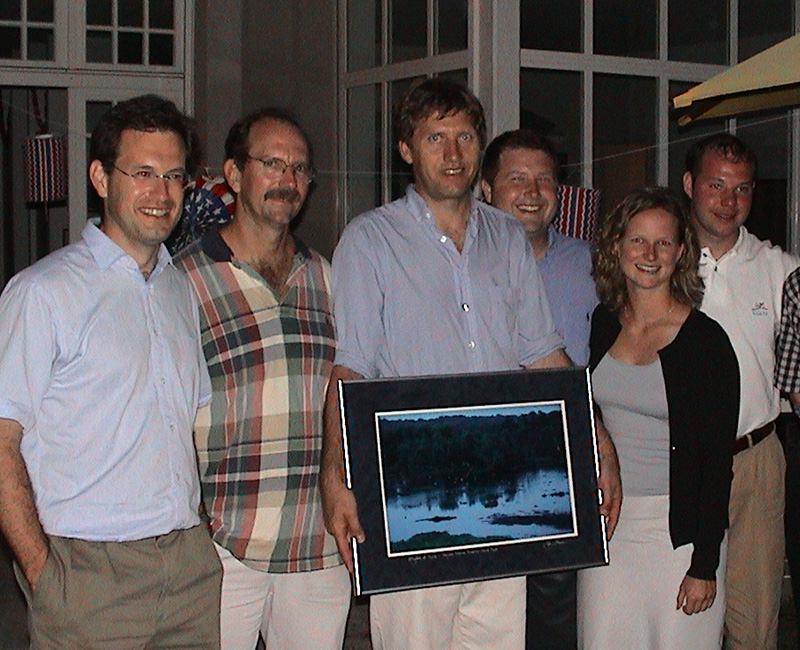GAINESVILLE, Fla. (March 19, 2024) –“The difference between the Equinoxe and other shoulder prostheses is that we started with a blank sheet of paper. We wanted to develop a prosthesis with no limitations to the innovation process,” says shoulder surgeon Pierre-Henri Flurin, MD.
Back in 2003, then-business analyst Darin Johnson and engineer Chris Roche met with Equinoxe design team surgeons Flurin, Thomas Wright, MD, and Joseph Zuckerman, MD, to start development of a new shoulder system: the Equinoxe® Shoulder. Equinoxe was the product name related to a French patent that Exactech had acquired a few months earlier, and it stuck due to its symbolism for balance.
We have continually and consistently come up with novel solutions to clinical problems that are faced by surgeons performing shoulder arthroplasty. This commitment to innovation and clinical research is the competitive advantage of Exactech and the Equinoxe, and I don't think that's present anywhere else in the world of shoulder arthroplasty.

The Early Equinoxe Days (pictured left to right): Laurent Angibaud, Thomas Wright, MD, Pierre-Henri Flurin, MD, Darin Johnson, Carla Benigni, Chris Roche
Dr. Flurin continues, “At the beginning, the idea was to provide an adaptable solution that was appropriate for a large group of patients. That’s why the prosthesis was designed to be able to accommodate any anatomy. It was not built for a particular patient.”
“Our team felt strongly that if we are going to develop something new, then we also all needed to perform the clinical research to ensure that it worked as it was intended to,” Dr. Zuckerman notes.
“And that is exactly what we did,” confirms Dr. Wright. “We enrolled our first Equinoxe patient in our multi-center registry, with the first surgery on November 17, 2004, and the three of us have continued enrolling and following those patients ever since. Clinical research is one of our key differentiators.”
Flash forward 20 years and the Equinoxe Shoulder is perhaps the most studied shoulder system in the world, with more than 300 peer-reviewed published papers and approximately 18,000 patients enrolled in Exactech’s clinical database.
Roche, now Exactech’s Senior Vice President and business unit leader for Extremities, comments, “Our surgeon team’s unwavering focus on clinical research has helped inform Exactech’s product development efforts to better understand and identify unmet clinical needs, and that knowledge has led to the creation of numerous innovative, first-to-market products that have empowered surgeons to help their patients get back to doing what they love.”
Adds Dr. Zuckerman, “We have continually and consistently come up with novel solutions to clinical problems that are faced by surgeons performing shoulder arthroplasty. This commitment to innovation and clinical research is the competitive advantage of Exactech and the Equinoxe, and I don’t think that’s present anywhere else in the world of shoulder arthroplasty.”
The Equinoxe team has developed many unique implants over the years, such as augmented aTSA/rTSA glenoids, Humeral Augmented Tray, Humeral Reconstruction prosthesis, and the Laser Cage Glenoid, while also adding shoulder solutions to the company’s Active Intelligence® line, including the Equinoxe® Planning App, ExactechGPS® navigation, Predict+® clinical decision support tool, and Chime Clinical Exchange App. Future plans include continuing to lead the way with transformative technologies like machine learning-based clinical decision support tool solutions that create value for shoulder arthroplasty patients and surgeons.

Pick Your Tech: From planning to placement, the Equinoxe Shoulder System helps empower surgeons to perform at their best.
“We are thankful for each of our loyal surgeon customers, who have trusted in Exactech and the Equinoxe these past 20 years,” says Johnson, now Exactech’s President and CEO. “We have been proud to partner with you to help you serve your patients, and we look forward to another 20 years of transformative collaboration!”
In celebration of Equinoxe’s 20th anniversary, below are a few of our most impactful Equinoxe studies that have been published in the past year, which highlight the broad scope and strength of its 20-year clinical history:
Roche, C. et al. Longitudinal Analysis of Shoulder Arthroplasty Utilization, Clinical Outcomes, and Value: A Comparative Assessment of Changes in Improvement Over 15 Years with a Single Platform Shoulder Prosthesis. J Shoulder Elbow Surg. 2023.
This 6,042-patient clinical study longitudinally analyzes primary anatomic total shoulder arthroplasty (aTSA) and primary reverse total shoulder arthroplasty (rTSA) outcomes and longitudinally analyzes utilization trends and adoption of new technology for the 6 clinical sites that have continuously enrolled patients in our multi-center study over a 15-year period. By quantifying selling price for each case and applying Porter’s healthcare value equation (e.g. ratio of outcomes to cost) the authors were able to quantify multiple different patient-focused measures of value for aTSA and rTSA at both short-term and mid-term follow-up timepoints. In doing so, Exactech was the first to objectively demonstrate that the adoption of new technology that has occurred over the 15-year period of analysis has resulted in significant improvements in clinical and radiographic outcomes and also significant improvements in value for patients receiving shoulder arthroplasty.
Rajabzadeh-Oghaz H, et al. Impact of Deltoid Computer Tomography Image Data on the Accuracy of Machine Learning Predictions of Clinical Outcomes after Anatomic and Reverse Total Shoulder Arthroplasty. J Clin Med. 2024.
This newly published study is the first to use machine learning (ML) to analyze preoperative CT image data combined with clinical outcome data for aTSA and rTSA patients. Data from this 1,057-patient study was used to create predictive models that identified the specific 3D volumetric deltoid muscle measurements and radiomic (CT image Hounsfield threshold based) measurements relevant to post-op outcomes after aTSA and rTSA. In doing so, the authors demonstrated how a CT-based ML framework could be deployed to fully leverage this image data to more objectively quantify a patient’s muscle (and bone) anatomy and better describe different disease states, to ultimately better characterize an individual patient’s potential for improvement after treatment. Finally, this study was able to demonstrate how preoperative planning software will utilize these predictive models to evolve into a novel ML based clinical decision support tool.
Simovitch, R. et al. Stratification of the Minimal Clinically Important Difference, Substantial Clinical Benefit, and Patient Acceptable Symptomatic State after Total Shoulder Arthroplasty by Implant Type, Preoperative Diagnosis, and Sex. J Shoulder Elbow Surg. 2024.
This newly published study of nearly 6,000 Equinoxe patients builds upon our most cited clinical research study (Simovitch et al., Quantifying success after total shoulder arthroplasty: the minimal clinically important difference, JSES 2018), which is an important contribution to the orthopedic literature because it, for the first time, reports the minimal clinically important difference (MCID) for many common patient-reported outcome measures and also for several measurements of active range of motion after both aTSA and rTSA. This study also demonstrates differences in MCIDs associated with gender, age, and follow-up duration. This new study expands on that previous work by analyzing the clinical outcomes of 5,851 shoulder arthroplasty patients (2,236 aTSA and 3,615 rTSA) to quantify the MCID, substantial clinical benefit (SCB), and patient acceptable symptomatic state (PASS) for sex and preoperative diagnosis, for both aTSA and rTSA.
Allen CA. et al. Evaluating the Fairness and Accuracy of Machine Learning-Based Predictions of Clinical Outcomes after Anatomic and Reverse Total Shoulder Arthroplasty. J Shoulder Elbow Surg. 2024.
This newly published ML analysis of 8,280 Equinoxe patients with 19,249 patient follow-up visits is the first orthopedic study to demonstrate that a ML-based clinical decision support tool (Predict+) can provide accurate predictions for patients of different age, sex, and ethnicity. To evaluate fairness, the study quantified the accuracy of Predict+ when predicting clinical outcomes for aTSA and rTSA for these 8,000 patients when stratified by multiple patient sub-groups of age, gender and ethnicity and compared differences in accuracy between patient groups. In doing so, the authors were able to identify precisely which patient groups received fair predictions and which patient groups received unfair predictions. The study reported that Predict+ was deemed fair for 98.6% of regression predictions, 99.4% of substantial clinical benefit (SCB) classification predictions, and 100% of minimal clinically important difference (MCID) classification predictions.
Parada SA. et al. Risk Factors for Rotator Cuff Tears and Aseptic Glenoid Loosening after Anatomic Total Shoulder Arthroplasty. Seminars in Arthroplasty: JSES. 2024.
This newly published study of 3,772 primary Equinoxe aTSA patients is the largest study to analyze risk factors for the two most common complications after aTSA: rotator cuff tears and aseptic glenoid loosening. A multivariate analysis was conducted to identify the patient demographic and comorbidities as well the implant and operative factors statistically associated with the occurrence of rotator cuff tears and aseptic glenoid loosening after aTSA. Specifically, these authors identified that aTSA patients with rotator cuff tears were more likely to have previous shoulder surgery and small size glenoids and aTSA patients with aseptic glenoid loosening were more likely to be younger (<62 years at the time of surgery), have small-size glenoids, and have a nonhybrid glenoids. Additionally, polyethylene shelf age at the time of implantation was not associated with the occurrence of either complication. Finally, odds ratios were calculated to identify specific patient cohorts with multiple risk factors to identify the patients with the greatest risk for each complication.
About Exactech
Exactech is a global medical device company that develops and markets orthopaedic implant devices, related surgical instruments and the Active Intelligence® platform of smart technologies to hospitals and physicians. Headquartered in Gainesville, Fla., Exactech markets its products in the United States, in addition to more than 30 markets in Europe, Latin America, Asia and the Pacific. Visit www.exac.com for more information and connect with us on LinkedIn, VuMedi, YouTube, Twitter and Instagram.
References
- Roche CP, Jones R, Routman H, Marczuk Y, Flurin PH, Wright TW, Zuckerman JD. Longitudinal Analysis of Shoulder Arthroplasty Utilization, Clinical Outcomes, and Value: A Comparative Assessment of Changes in Improvement over 15 Years with a Single Platform Shoulder Prosthesis. J Shoulder Elbow Surg. 2023 Aug;32(8):1562-1573. doi: 10.1016/j.jse.2022.12.018.
- Rajabzadeh-Oghaz H, Kumar V, Berry DB, Singh A, Schoch BS, Aibinder WR, Gobbato B, Polakovic S, Elwell J, Roche CP. Impact of Deltoid Computer Tomography Image Data on the Accuracy of Machine Learning Predictions of Clinical Outcomes after Anatomic and Reverse Total Shoulder Arthroplasty. J Clin Med. 2024 Feb 23;13(5):1273. doi: 10.3390/jcm13051273.
- Simovitch R. Elwell J, Colasanti C, Hao KA, Friedman R, Flurin PH, Wright TW, Schoch BS, Roche CP, Zuckerman JD. Stratification of the Minimal Clinically Important Difference, Substantial Clinical Benefit, and Patient Acceptable Symptomatic State after Total Shoulder Arthroplasty by Implant Type, Preoperative Diagnosis, and Sex. JSES. 2024. In press
- Allen C, Kumar V, Elwell J, Overman S, Schoch BS, Aibinder W, Parsons M, Watling J, Ko JK, Gobbato B, Throckmorton T, Routman H, Roche CP. Evaluating the Fairness and Accuracy of Machine Learning-Based Predictions of Clinical Outcomes after Anatomic and Reverse Total Shoulder Arthroplasty. J Shoulder Elbow Surg. 2024 Apr;33(4):888-899. doi: 10.1016/j.jse.2023.08.005.
- Simovitch R, Flurin PH, Wright T, Zuckerman JD, Roche CP. Quantifying Success after Total Shoulder Arthroplasty: The Minimal Clinically Important Difference. J Shoulder Elbow Surg. 2018 Feb;27(2):298-305. doi: 10.1016/j.jse.2017.09.013.
- Stephen A. Parada, Chris Peach, Wen Fan, Josie Elwell, Pierre-Henri Flurin, Thomas W. Wright, Joseph D. Zuckerman, Christopher P. Roche. Risk factors for rotator cuff tears and aseptic glenoid loosening after anatomic total shoulder arthroplasty, Seminars in Arthroplasty: JSES. 2024. In press.
Predict+ has not received FDA marketing authorization
